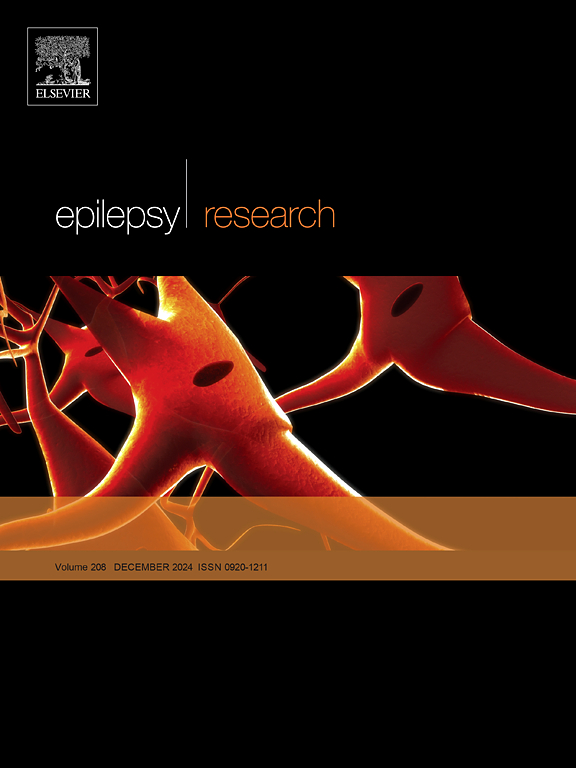Efficacy and safety of perampanel in genetic generalized epilepsy: A retrospective, single-center study in China
IF 2
4区 医学
Q3 CLINICAL NEUROLOGY
引用次数: 0
Abstract
Perampanel (PER) is a selective non-competitive AMPA receptor antagonist approved for treating focal and generalized seizures. However, its efficacy in genetic generalized epilepsy (GGE) has not been extensively studied in Chinese populations. This retrospective, single-center study enrolled 54 patients with GGE treated with PER between March 2021 and November 2023. To ensure data quality and minimize bias, we implemented standardized data collection procedures including: (1) systematic documentation using standardized seizure diaries, (2) regular follow-up assessments at predefined intervals, and (3) rigorous application of inclusion/exclusion criteria. Efficacy was assessed by seizure freedom rate, responder rate (≥50 % seizure reduction) and retention rate at 3, 6, 12 months and last follow-up. Safety was evaluated by monitoring adverse events. At last follow-up (mean 14 ± 4.95 months), the overall seizure freedom rate was 53.7 % and responder rate was 70.4 %. Idiopathic generalized epilepsy (IGE) patients showed better outcomes compared to non-IGE patients (seizure freedom: 63.6 % vs 10 %; responder rate: 79.5 % vs 30 %). PER demonstrated highest efficacy in generalized tonic-clonic seizures (80.4 % responder rate), followed by myoclonic (70.8 %) and absence seizures (50 %). Among epilepsy syndromes, GTCA showed the best response (100 % responder rate), followed by JME (83.3 %). The mean effective dose was 3.86 mg/day in the seizure-free group. Treatment-emergent adverse events occurred in 18.5 % of patients, with dizziness (18.5 %) being most common, leading to discontinuation in 3.7 % of cases. PER demonstrated favorable efficacy and tolerability in Chinese patients with GGE, particularly in IGE patients and those with generalized tonic-clonic seizures. Lower doses were associated with better outcomes, suggesting careful dose titration may optimize therapeutic benefits.
perampanel治疗遗传性广泛性癫痫的疗效和安全性:一项中国单中心回顾性研究
Perampanel (PER)是一种选择性非竞争性AMPA受体拮抗剂,被批准用于治疗局灶性和全面性癫痫发作。然而,其对遗传性广泛性癫痫(GGE)的疗效尚未在中国人群中得到广泛研究。这项回顾性单中心研究在2021年3月至2023年11月期间招募了54例接受PER治疗的GGE患者。为了确保数据质量并最大限度地减少偏差,我们实施了标准化的数据收集程序,包括:(1)使用标准化的癫痫发作日记进行系统记录,(2)按预定的时间间隔进行定期随访评估,(3)严格应用纳入/排除标准。通过3个月、6个月、12个月和最后一次随访时的癫痫发作自由率、应答率(≥50 %癫痫发作减少率)和保留率来评估疗效。通过监测不良事件来评估安全性。最后一次随访(平均14 ± 4.95个月),总发作自由率为53.7 %,应答率为70.4 %。特发性全面性癫痫(IGE)患者与非IGE患者相比表现出更好的结果(癫痫发作自由度:63.6 % vs 10 %;应答率:79.5 % vs 30 %)。PER在全身性强直-阵挛发作中表现出最高的疗效(80.4 %应答率),其次是肌阵挛发作(70.8 %)和失神发作(50 %)。在癫痫综合征中,GTCA的反应率最高(100 %),其次是JME(83.3 %)。无发作组平均有效剂量为3.86 mg/d。18.5% %的患者发生治疗后出现的不良事件,其中头晕(18.5% %)最为常见,导致3.7 %的患者停药。PER在中国GGE患者中表现出良好的疗效和耐受性,特别是在IGE患者和全身性强直-阵挛性癫痫患者中。较低的剂量与较好的结果相关,表明谨慎的剂量滴定可以优化治疗效果。
本文章由计算机程序翻译,如有差异,请以英文原文为准。
求助全文
约1分钟内获得全文
求助全文
来源期刊

Epilepsy Research
医学-临床神经学
CiteScore
0.10
自引率
4.50%
发文量
143
审稿时长
62 days
期刊介绍:
Epilepsy Research provides for publication of high quality articles in both basic and clinical epilepsy research, with a special emphasis on translational research that ultimately relates to epilepsy as a human condition. The journal is intended to provide a forum for reporting the best and most rigorous epilepsy research from all disciplines ranging from biophysics and molecular biology to epidemiological and psychosocial research. As such the journal will publish original papers relevant to epilepsy from any scientific discipline and also studies of a multidisciplinary nature. Clinical and experimental research papers adopting fresh conceptual approaches to the study of epilepsy and its treatment are encouraged. The overriding criteria for publication are novelty, significant clinical or experimental relevance, and interest to a multidisciplinary audience in the broad arena of epilepsy. Review articles focused on any topic of epilepsy research will also be considered, but only if they present an exceptionally clear synthesis of current knowledge and future directions of a research area, based on a critical assessment of the available data or on hypotheses that are likely to stimulate more critical thinking and further advances in an area of epilepsy research.
 求助内容:
求助内容: 应助结果提醒方式:
应助结果提醒方式:


